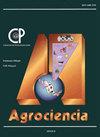秘鲁东北部三个不同地区种植的枇杷果实中生物活性化合物的变化
IF 0.5
4区 农林科学
Q4 AGRICULTURE, MULTIDISCIPLINARY
引用次数: 0
摘要
近年来,人们对植物代谢的生物活性化合物越来越感兴趣,这些化合物是人类饮食的重要营养来源,几乎存在于所有蔬菜和水果中。目的是评价枇杷果实成熟过程中生物活性物质的变化。为此,从位于秘鲁东北部的亚马逊地区的三个不同生产地点,在三个不同的成熟阶段收集水果。测定样品的颜色、总酚含量(Folin-Ciocalteu法)、抗氧化活性(DPPH自由基法)和总黄酮(比色法)。资料进行方差分析,均数比较采用Tukey检验(p≤0.05)。颜色和生物活性化合物取决于成熟阶段,在较小程度上取决于水果的来源。成熟的水果含有较高的酚类化合物和类黄酮含量(高达5倍),可用于食品和制药工业。本文章由计算机程序翻译,如有差异,请以英文原文为准。
CHANGES IN BIOACTIVE COMPOUNDS IN FRUITS OF Eriobotrya japonica GROWN IN THREE DIFFERENT LOCATIONS IN NORTHEASTERN PERU
Recently, there has been a growing interest in bioactive compounds metabolized by plants, which are an important nutritional source for the human diet and are found in almost all vegetables and fruits. The objective was to evaluate the changes of bioactive compounds during the ripening of loquat (Eriobotrya japonica) fruit. For this purpose, fruits were collected at three different stages of ripening from three different production sites in the Amazon region, located in northeastern Peru. Color, total phenolic content (Folin-Ciocalteu method), antioxidant activity (DPPH free radical method) and total flavonoids (colorimetric assay) were determined for all samples. Data were subjected to analysis of variance and means were compared by Tukey’s test (p ≤ 0.05). Color and bioactive compounds depend on the stage of ripening and, to a lesser extent, on the origin of the fruit. Ripe fruits have a higher content of phenolic compounds and flavonoids (up to five times higher) that can be used in the food and pharmaceutical industry.
求助全文
通过发布文献求助,成功后即可免费获取论文全文。
去求助
来源期刊

Agrociencia
农林科学-农业综合
CiteScore
0.50
自引率
33.30%
发文量
51
审稿时长
18-36 weeks
期刊介绍:
AGROCIENCIA is a scientific journal created and sponsored by the Colegio de Postgraduados. Its main objective is the publication and diffusion of agricultural, animal and forestry sciences research results from mexican and foreign scientists. All contributions are peer reviewed. Starting in the year 2000, AGROCIENCIA became a bimonthly and fully bilingual journal (Spanish and English versions in the same issue). Since 2007 appears every month and a half (eight issues per year). In addition to the printed issues, the full content is available in electronic format.
 求助内容:
求助内容: 应助结果提醒方式:
应助结果提醒方式:


